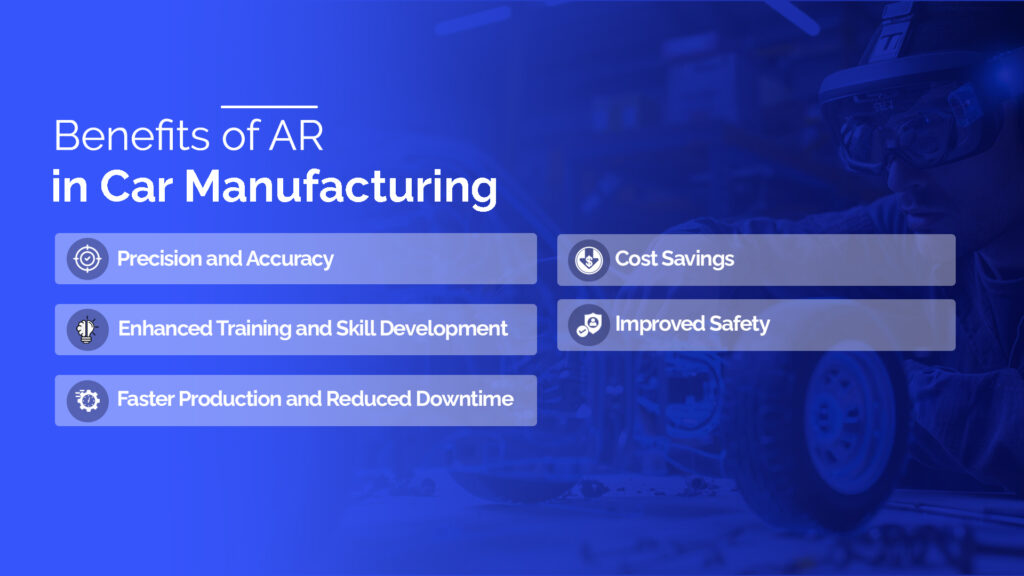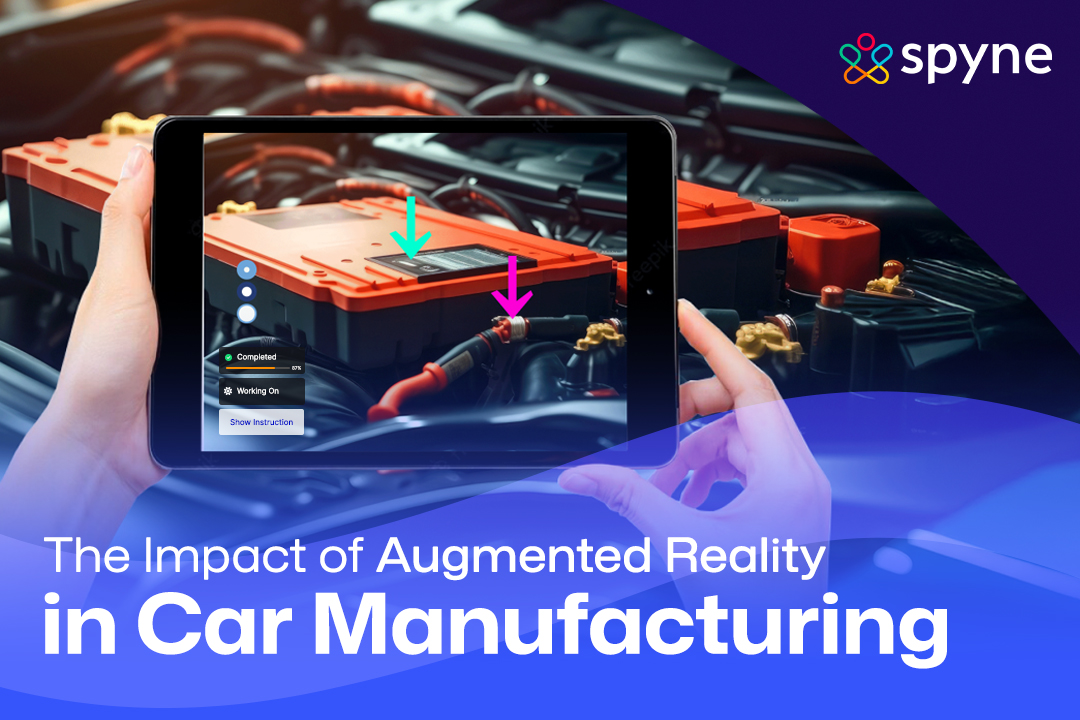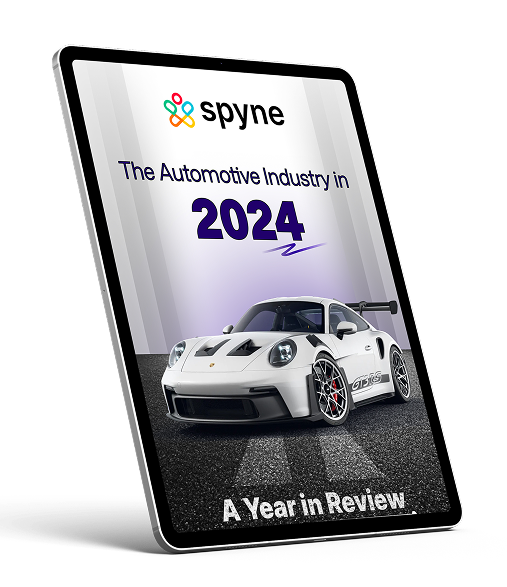Augmented Reality in car manufacturing is changing how vehicles are designed, assembled, and produced, bringing a whole new level of efficiency and precision. AR in the automotive industry is no longer just a futuristic idea. Instead, it’s being actively utilized to increase accuracy in vehicle production.
Overlaying digital information on physical components is helping AR technology in car manufacturing to ensure that workers can follow real-time guidance. This leads to reduced errors and improvement in the quality of the assembly process.
This blog will explore how augmented reality automotive transforms car manufacturing. From improving precision on the assembly line to enhancing quality control and training, AR is making the process faster and more efficient. We’ll also look at how it’s shaping the future of car design and maintenance.
Definition and Role of AR in Automotive Industry
In simple terms, AR is a technology that projects digital information like images, models, and instructions onto the real world. In car manufacturing, this technology helps bridge the physical and digital worlds by offering real-time, interactive visualizations that improve accuracy, efficiency, and safety.
The role of AR in the automotive industry goes beyond just visualization. It has become an essential and sought-after tool for improving precision, training, and optimizing workflows. Incorporating AR technology in car manufacturing helps workers access on-the-spot instructions or 3D models directly on the assembly line.
This capability means people don’t have to rely on paper manuals and digital screens, which in turn helps streamline operations and minimize human error. Augmented Reality in Car Manufacturing provides an interactive, intuitive experience that drives higher productivity and faster decision-making. It could help guide assembly tasks, support quality control, or help with complex troubleshooting.
As AR in automobile manufacturing continues to expand, its role has grown even more integral. Automotive augmented reality solutions have become indispensable. This combination of physical and digital worlds is changing how the entire automotive industry operates.

Augmented Reality in Vehicle Production
AR is reshaping how vehicles are produced, significantly improving both the process and the people involved. Employing vehicle inspection technologies and showing relevant instructions can change the way automotive manufacturing is done. Imagine seeing step-by-step instructions, 3D car view, and real-time data right in front of you as you work on the production line. This is precisely what augmented reality in vehicle production allows.
- It removes the need for paper manuals or even digital screens because the information you need is displayed directly in your sight, making everything much more intuitive.
- During assembly, AR projects digital guides onto the physical parts workers handle. This means they’re assembling the components correctly without stepping away to check instructions. No more guesswork or second-guessing whether a part goes in the right spot.
- AR also speeds up the entire production process. Because workers can access real-time instructions and digital models, they don’t waste time flipping through manuals or trying to find information elsewhere. Everything they need is before them, allowing for faster decision-making and reducing mistakes. This leads to a significant reduction in production time, improving output without compromising quality.
- AR helps design teams, too, allowing them to visualize parts and entire vehicles in 3D before they’re built. They can spot potential design issues early, make quick adjustments, and test out different configurations virtually, all of which reduce costs and time spent on physical prototypes.
Integrating augmented reality in vehicle production ultimately helps manufacturers deliver high-quality vehicles faster and more cost-effectively.
Benefits of AR in Manufacturing
You wouldn’t believe how much Augmented Reality (AR) in car manufacturing in car merchandising is changing the way cars are made. It’s making car manufacturing way more competent and more efficient. Let’s walk you through how AR in automotive manufacturing is helping the industry.

Precision and Accuracy
One of the biggest wins of using AR technology in car manufacturing is how it helps workers assemble parts with incredible precision. Imagine seeing digital instructions right on top of the physical part you’re working on.
AR overlays show precisely where things must go, helping workers avoid mistakes and get it right the first time. It’s making the whole assembly process more accurate and reducing errors in production.
Enhanced Training and Skill Development
Another tremendous benefit is how AR is changing how workers get trained. In traditional car production, you must learn by trial and error. Still, with AR applications in car production, you can immerse yourself in virtual scenarios that mimic real-life situations on the floor.
This way, new workers get hands-on experience before stepping into the real world, which helps them feel more confident and ready. It makes training faster and more effective, thereby increasing productivity and assisting workers to build their skills quickly.
Faster Production and Reduced Downtime
AR can help with accuracy and speed things up. In the past, workers had to keep checking manuals or computer screens for instructions. However, with AR headsets or smart glasses, workers get real-time instructions right before them.
This makes the process quicker and lets them stay focused on what they’re doing. With fewer distractions, they can move faster, which helps reduce downtime and makes production smoother.
Cost Savings
Manufacturers are always looking for ways to save money, and AR helps here, too. With faster assembly and better training, companies can cut labor costs and avoid mistakes that waste materials. Also, before making actual car parts, manufacturers can test designs virtually using AR, reducing the need for physical prototypes. This saves time and resources, speeding up the overall production cycle and ultimately reducing costs.
Improved Safety
Safety is a big deal in car manufacturing; AR takes it up a notch. AR applications in car production can display safety guidelines and warnings directly on the worker’s screen, so they’re always aware of potential hazards. Whether it’s reminding them of safety protocols or helping them check equipment, AR ensures workers follow the proper procedures and stay safe.
AR in Automotive Quality Control and Inspections
Quality control is a massive deal in car manufacturing because every part needs to meet strict standards, and AR is helping make sure that happens with more accuracy and speed.
With AR in automotive quality control, manufacturers can do more thorough inspections. Instead of relying on paper checklists or external reference tools, inspectors can use AR to superimpose digital information directly onto the physical parts they’re checking. So, if there’s a flaw or a discrepancy, it’ll pop up right in front of them, making it way easier to spot problems.
For example, automotive augmented reality solutions allow inspectors to compare real-time images of the parts against the digital models. It’s almost like a comparison tool, showing exactly where the part might not match the expected design, which helps fix issues before they leave the production line. This process is way faster and more precise than older methods, where inspectors had to cross-reference everything manually.
But it doesn’t stop here. AR also makes automated inspections possible. Using sensors and cameras, AR guides inspectors step-by-step, showing exactly where they need to focus. This reduces the chance of missing something, ensuring that the quality check is thorough every single time.
Lastly, AR helps with tracking and documenting inspections. Instead of writing everything down manually, AR devices can automatically log and store results digitally, making it easier to reference data later. It adds a whole new level of traceability and helps maintain high-quality standards across the board.
The Integration of AR with Other Technologies
As Augmented Reality (AR) in car manufacturing continues to gain momentum, its integration with other emerging technologies is taking things to a whole new level.
- One of the most exciting developments is the combination of AR in automotive industry processes with Artificial Intelligence (AI), the Internet of Things (IoT), and Machine Learning (ML).
- When AR technology in car manufacturing is paired with AI, the potential for predictive maintenance becomes even more impressive. Imagine AR guiding a worker through a car assembly task while using AI to analyze data from sensors embedded in the machines. This allows AR to assist in real-time decision-making and predict when a machine might need maintenance or adjustments.
- The integration of AR with IoT-enabled devices can optimize vehicle production by allowing AR applications to receive real-time updates about the status of various production tools or vehicles on the line. This makes the entire process more responsive and adaptable to changes, minimizing downtime and improving efficiency.
- By combining AR with these advanced technologies, automotive manufacturers can create smarter, more efficient production environments. Automotive augmented reality solutions are no longer just about helping workers, now they can also help predict problems, optimize production workflows, and even create more personalized experiences for customers.
This convergence propels AR technology in car manufacturing toward a future where it’s an important part of a highly automated and intelligent ecosystem.
AR in Automotive Aftermarket and Maintenance
The role of augmented reality in car manufacturing extends well beyond the assembly line. It’s now making waves in the automotive aftermarket and vehicle maintenance sectors, providing revolutionary solutions that help keep vehicles in top condition long after rolling off the production floor.
Streamlining Maintenance
With AR in automotive industry tools, a 3D model of the engine’s components can be projected right in front of the mechanics working on complex engines. This helps them visualize and interact with each part in real time, making the repair process faster. It also ensures that the repairs are done correctly the first time, leading to minimized errors and the need for rework.
Simplified Diagnostics
Augmented reality in vehicle production doesn’t stop at assembly. It’s incredibly valuable for diagnostics. AR in automobile manufacturing helps mechanics to access digital information about complex components directly in their line of sight.
Troubleshooting and Training
Automotive augmented reality solutions provide trainees with an interactive and hands-on experience in vehicle repair without the limitations of traditional training methods. It also helps experienced technicians troubleshoot complex issues by providing immediate access to visual diagrams and troubleshooting instructions without having to interrupt the repair process.
Improving Safety
While working on vehicles, safety becomes the top priority. With AR applications in car production, mechanics can instantly see safety alerts, reminders and guidelines on their screens, this makes sure they follow the correct protocols and minimizes the likelihood of accidents or injury.
Preventive Maintenance
AR also plays a massive role in preventive maintenance, working alongside AI and IoT systems to monitor vehicle health. Technicians can receive early warnings and potential issues, helping them address problems before they start escalating.
Accessible and Sustainable Maintenance
As augmented reality in vehicle production continues to mature, its maintenance applications will only become more refined. Integrating automotive augmented reality solutions with other technologies like AI and machine learning will result in an even more seamless repair process. Reducing human error and the need for costly physical prototypes will make maintenance practices more sustainable.
Future of AR in Car Manufacturing
The future of AR in car manufacturing is looking bright, like next-level bright. AR technology in car manufacturing will only get more integrated and advanced as the automotive industry embraces digital transformation. Right now, we’re already seeing AR change how cars are produced, but it could drive even more innovation in the future.
Though tablets and smartphones are currently used for AR applications, we’ll see even more smart glasses and wearables used on production lines to give workers real-time data and guidance. If AR were combined with AI, we could have predictive maintenance systems, meaning AR would not just help workers build cars but also prevent issues before they even happen.
As the industry moves toward more sustainable practices, AR will also help minimize waste by enabling more accurate designs and prototypes. So, not only will production be more innovative, but it will also be more sustainable.
Conclusion
In short, AR is no longer a futuristic “what if”, it’s already a way ahead in the automotive industry. From making car production more efficient and precise to revolutionizing quality control and customer experiences, AR technology in car manufacturing is making huge strides. The benefits are clear: faster production, fewer errors, better training, and a more sustainable approach to making vehicles.
With automotive augmented reality solutions becoming an important part of the production process, we’re seeing massive improvements in everything from design and assembly to maintenance and even customer service. As AR applications in car production continue to grow, it’s clear that the automotive industry is headed toward an even more advanced, innovative future.



























